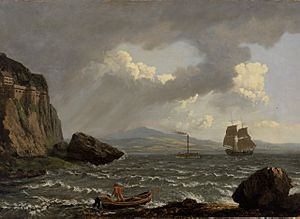John Wilson (painter, born 1774) facts for kids
John H. "Jock" Wilson (born in 1774 in Ayr, Scotland – died in 1855 in Folkestone, England) was a famous Scottish artist. He was known for painting beautiful landscapes and scenes of the sea. He also became the president of the Society of British Artists in 1827.
Contents
Early Life and Art Training
John Wilson started learning about art at a young age. When he was thirteen, he became an apprentice to a decorator named John Norrie in Edinburgh. This means he worked for Norrie to learn the trade. Later, he learned how to paint landscapes from a well-known artist named Alexander Nasmyth.
For about two years, Wilson lived in a town called Montrose. There, he continued to paint landscapes. He also taught drawing to others.
Moving to London and Exhibiting Art
In 1798, John Wilson moved to London. He started painting scenery for theatres, like Astley's Amphitheatre. Imagine painting the backdrops for plays and shows!
He was a very busy artist. From 1807 to 1855, he showed 76 of his paintings at the Royal Academy. This was a very important art exhibition. He also showed 144 paintings at the British Institution between 1813 and 1854.
Achievements and Recognition
In 1825, John Wilson won a special prize of £100 from the British Institution. He won it for his painting called The Battle of Trafalgar. This painting was later bought by a rich collector, Lord Northwick. In 2010, the painting was given to the East Ayrshire Council. It is now displayed at the Baird Institute in Cumnock.
John Wilson was also one of the artists who helped start the Society of British Artists. He showed many of his artworks there throughout his life. In 1827, he was chosen to be the president of this society. That same year, he also became an honorary member of the Scottish Academy.
A Family of Artists
John Wilson's artistic talent ran in his family. His son, John James Wilson (1818–1875), also became a painter. He was sometimes called "Young Jock." John Wilson's grandson, William John Wilson (1833–1909), continued the family tradition. He worked as a theatre scene painter and manager, just like his grandfather had done.


